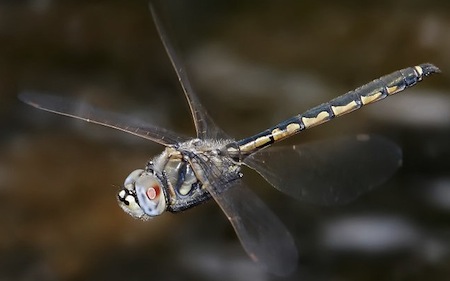Science Fiction
Dictionary
A B C D E F G H I J K L M N O P Q R S T U V W X Y Z
Bio-Mechanics And Micro-Robotic Flight

It seems perfectly natural to use insects as the basis for fictional micro-robotic flight. That's exactly what Raymond Z. Gallun did in his 1936 classic short story The Scarab, using a flying beetle to evoke the idea of a tiny robotic flying machine:
...the Scarab buzzed into the great workroom as any intruding insect might, and sought the security of a shadowed corner.
Is the key to micro air vehicles (MAVs) to be found in the bio-mechanics of insects? John Loughmiller, an electrical engineer and commercial pilot writing in Design News, thinks so.
The Scarab rubbed its hind legs together, as flies will do when at rest. Then, apparently satisfied that it was in condition, it unfolded the coleoptera-like plates over its wings. With a buzz that any uninformed person would have mistaken for that of a beetle, it started out on its journey...
(Read more about scarab beetle robotic flyer)

(Dragonfly in flight)
Note the positions of the Dragonfly’s four wings. The two front wings are in a stable position in this still frame and appear to be generating equal lift. The two back wings however do not match the position of the front wings nor do they match positions relative to one another. It appears that this Dragonfly is in the process of executing a lateral maneuver from a hover by inducing drag with the rear wings in unequal amounts. The resulting complex vortices can only be analyzed using Computational Fluid Dynamics.“An airfoil uses aerodynamic lift to carry its weight. But the dragonfly uses a lot of aerodynamic drag to carry its weight. That is weird, because with airplanes you always think about minimizing drag. You never think about using drag.”
When the Dragonfly is moving forward, the two sets of wings are flapped in phase, generating lift and directional momentum.
When hovering however, the rear wings are intentionally flapped out of phase, with both the angle of attack and relative position of the front wings, which generates drag preventing motion relative to the earth but still generating lift. By decoupling one rear wing’s movement from the other, the insect can also move side to side.
All of these maneuvers require understanding of the vortices involved, because the vortices cancel or enhance lift as they interact, so a flexible CFD toolset is required.
But if these motions can be duplicated mechanically, they could give a micro-robot the ability to move rapidly from one location to another and then hover for purposes of surveillance. All the while the micro-robotic mini-spy would be generating an extremely small visual and Radar footprint plus an equally small noise signature.
Capabilities like these are of great interest to the military and law enforcement.
Read other detailed examples at Design News.
Scroll down for more stories in the same category. (Story submitted 11/11/2009)
Follow this kind of news @Technovelgy.| Email | RSS | Blog It | Stumble | del.icio.us | Digg | Reddit |
Would
you like to contribute a story tip?
It's easy:
Get the URL of the story, and the related sf author, and add
it here.
Comment/Join discussion ( 0 )
Related News Stories - (" Engineering ")
Jetson ONE Air Races Begin, Can Air Polo Be Far Behind?
'If you're one of those rarities who haven't attended a rocket-polo "carnage", let me tell you it's a colorful affair.' - John Victor Peterson, 1938.
X-Control Janus-1 A Suitcase Aircraft
'You will notice that it... fits the suitcase nicely.' - E.D. Skinner, 1929.
Time Crystals Can Now Be Seen Directly
'It is as you thought when you constructed the time crystal, my master Vaylan.' - NK Heming, 1952.
China Steals Strato Airship Design From Google App Engine
'...war-balloons, or, as it would be more correct to call them, navigable aerostats.' - George Griffith, 1893.
Technovelgy (that's tech-novel-gee!) is devoted to the creative science inventions and ideas of sf authors. Look for the Invention Category that interests you, the Glossary, the Invention Timeline, or see what's New.
Science Fiction
Timeline
1600-1899
1900-1939
1940's 1950's
1960's 1970's
1980's 1990's
2000's 2010's
Current News
Jetson ONE Air Races Begin, Can Air Polo Be Far Behind?
'If you're one of those rarities who haven't attended a rocket-polo "carnage", let me tell you it's a colorful affair.'
Will Space Stations Have Large Interior Spaces Again?
'They filed clumsily into the battleroom, like children in a swimming pool for the first time, clinging to the handholds along the side.'
Mornine Sales Robot
'Robot-salesmen were everywhere, gesturing...'
Bipedal Robot Floats Gently While Walking
'a walking balloon proceeded with long strides of its aluminum legs...'
Musk Idea Of Cars Talking To Each Other Predicted 70 Years Ago
'My cars talk to one another.'
Elegant Bivouac Shelter Produces Water And Electricity
'There was nowhere on the planet where science and technology could not provide one with a comfortable home...'
X-Control Janus-1 A Suitcase Aircraft
'You will notice that it... fits the suitcase nicely.'
'AI Assistants' Are Actually Less Reliable For News
'Most men updated their PIP on New Year's Day...'
YES!! Remote Teleoperated Robots predicted by Technovelgy!
'...a misshapen, many-tentacled thing about twice the size of a man.'
Will Robots Ever Fold Landry?
Where have you gone, Mrs. Robinson?
Will AIs Give Better Results If You're Rude To Them?
'I said, "Listen up, motherf*cker.'
Cybertruck Robotic Arm F10 Drone Launch!
Drone away!
Black Fungus Blocks Radiation
'You were surrounded by Astrophage most of the time'
Liuzhi Process Now In Use In China
'He was in a high-ceilinged windowless cell with walls of glittering white porcelain.'
Reflect Orbital Offers 'Sunlight on Demand' And Light Pollution
'I don't have to tell you about the seven two-mile-diameter orbital mirrors...'
Will Robots Become Family Caregivers?
'The robant and the tiny old woman entered the control room slowly...'
